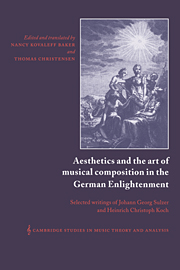 Aesthetics and the Art of Musical Composition in the German Enlightenment
Aesthetics and the Art of Musical Composition in the German Enlightenment Book contents
- Frontmatter
- Contents
- Foreword by Ian Bent
- PART I JOHANN GEORG SULZER GENERAL THEORY OF THE FINE ARTS (1771–74): SELECTED ARTICLES
- PART II HEINRICH CHRISTOPH KOCH INTRODUCTORY ESSAY ON COMPOSITION, VOL. II (1787)
- Introduction by Nancy Kovaleff Baker
- Preface
- Introduction
- I The aim and the inner nature of compositions and, above all, the way in which they arise
- Index
Introduction
Published online by Cambridge University Press: 30 September 2009
- Frontmatter
- Contents
- Foreword by Ian Bent
- PART I JOHANN GEORG SULZER GENERAL THEORY OF THE FINE ARTS (1771–74): SELECTED ARTICLES
- PART II HEINRICH CHRISTOPH KOCH INTRODUCTORY ESSAY ON COMPOSITION, VOL. II (1787)
- Introduction by Nancy Kovaleff Baker
- Preface
- Introduction
- I The aim and the inner nature of compositions and, above all, the way in which they arise
- Index
Summary
The very relationship between tones which makes it possible to join them harmonically also enables them to be connected melodically. A series of successive tones which share this relationship, that is, tones of an underlying key connected in a successive series, is called a melody.
A composition contains just as many different melodies as there are voices present. {4} Although (as we shall see) the main directions of these voices must arise in the soul of the creating composer together as one single picture to attain the proper aim of art, nevertheless these voices are not of one and the same nature, they do not have a common purpose. One of them contains, as it were, the sketch of the painting, the precise content of the ideal of the composer; this is called the principal part. Another serves him as the basis for the harmonic texture with which this picture is painted; this is called the bass voice. Others are present to contribute the drapery, the decoration, and finishing touches; these are called middle, filling, or subsidiary voices. The principal part of a composition is the one which, in the mechanical section of this treatise, I call the melody.
Remark
There are compositions, and even more single movements of them, in which {5} more than one voice has the character of principal part; in such pieces, the proper melodic content of the composer's idea may be realized only through the uniting of these voices.
- Type
- Chapter
- Information
- Aesthetics and the Art of Musical Composition in the German EnlightenmentSelected Writings of Johann Georg Sulzer and Heinrich Christoph Koch, pp. 139 - 143Publisher: Cambridge University PressPrint publication year: 1996


